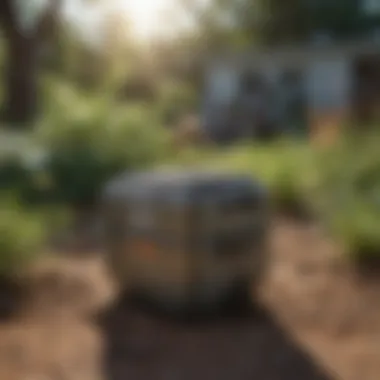Effective Strategies to Keep Mosquitoes Away


Intro
Mosquitoes are more than just a nuisance; they pose health risks as they can transmit diseases. Understanding their behavior and habits is essential for effective control measures. This comprehensive guide will cover strategies aimed at keeping mosquitoes out of your yard. By integrating simple practices and eco-friendly solutions, you can improve your outdoor enjoyment.
Understanding Pests
Definition of Pests
Pests are organisms that interfere with human activities, especially in agricultural or residential settings. In the context of mosquitoes, these small, flying insects belong to the family Culicidae. They are known for their blood-sucking habits, which not only disturb outdoor peace but also pose health threats.
Importance of Pest Identification
Identifying pests accurately is crucial. Not all mosquitoes are harmful, yet species like Aedes aegypti and Anopheles gambiae are known vectors for diseases such as dengue and malaria. Recognizing which species inhabit your area allows for targeted prevention measures. Furthermore, understanding their breeding grounds helps in limiting their population.
Prevention Techniques
Home and Garden Preventative Measures
Preventing mosquitoes starts at home. Here are several techniques that can be effective:
- Remove Standing Water: Mosquitoes breed in stagnant water. Regularly check for and eliminate water in plant pots, bird baths, or clogged gutters.
- Maintain Lawn and Garden: Keep grass trimmed and remove dense foliage where mosquitoes can rest.
- Use Plant Barriers: Certain plants, such as citronella and marigolds, can naturally repel mosquitoes. Integrating these in your garden can serve as an additional barrier.
Seasonal Prevention Tips
Different seasons may necessitate different strategies:
- Spring: Inspect your property for any accumulated winter water. Start a routine of mowing and weeding.
- Summer: Increase awareness during peak mosquito activity. Use fans in outdoor spaces to create air movement that mosquitoes dislike.
- Fall: Prepare your yard for winter. Removing debris can reduce mosquito habitats.
Eco-Friendly Pest Control Solutions
Overview of Sustainable Practices
Sustainable pest control focuses on minimizing chemical use while effectively managing pest populations. Strategies include:
- Encouraging Natural Predators: Birds, bats, and dragonflies help control mosquito populations. Creating habitats for these species can enhance natural pest control.
- Natural Waste Disposal: Recycle organic waste properly to avoid attracting pests. Composting also can be managed in such a way that does not become a breeding ground.
Natural Remedies and Their Effectiveness
Some homeowners prefer natural remedies. Common options include:
- Essential Oils: Oils like eucalyptus, lavender, and tea tree can repel mosquitoes. Diluting and applying these to skin or clothing can be effective.
- Garlic Spray: Some studies suggest that garlic can repel mosquitoes. Mixing garlic juice with water and spraying it around the yard may reduce mosquito attraction.
Integrating both prevention measures and eco-friendly solutions creates a harmonious outdoor space without sacrificing pest control.
As we proceed with this guide, we will delve deeper into each solution, providing practical tips and insights for homeowners aiming to enjoy their yards without the intrusion of mosquitoes.
Understanding Mosquito Behavior
Understanding the behavior of mosquitoes is essential for effective prevention strategies. Mosquitoes are not just random insects; they have specific habits and traits that influence where they breed and how they interact with humans. By knowing how mosquitoes think and act, homeowners can take proactive measures to limit encounters with these pests.
Life Cycle of Mosquitoes
The life cycle of mosquitoes is crucial in understanding their population dynamics. It consists of four main stages: eggs, larvae, pupae, and adults. Each stage has its own characteristics that inform strategies for control.
Eggs
The eggs of mosquitoes are often laid in or near standing water, making this stage vital to the overall breeding strategy. A key characteristic of mosquito eggs is their ability to survive dry conditions for extended periods. This adaptability allows them to endure unfavorable environmental conditions, enabling rapid population increases once favorable conditions arise. This behavior makes eggs a beneficial focus area for prevention efforts. By eliminating any standing water, homeowners can reduce the potential for mosquitos reaching adulthood.
Larvae
Once eggs hatch, the larvae emerge. These young insects live in water and are dependent on it for survival. A significant feature of larvae is their feeding habits; they consume organic matter in water, which makes them vulnerable to control tactics such as introducing certain fish that eat larvae. This creates an additional approach for yard management. There is, however, a downside to larvae: their presence indicates nearby standing water, which needs to be addressed as part of a comprehensive prevention plan.
Pupae
The pupal stage is a transitional phase where the larvae form cocoons. This stage is less vulnerable than larvae but is crucial for the transition to adulthood. Notably, although pupae can survive in various aquatic environments, they are also sensitive to temperature and water quality. Understanding this phase helps in timing intervention strategies to avoid the emergence of adult mosquitoes.
Adults
Once the pupal stage culminates, adult mosquitoes emerge. A key characteristic of adults is their dietary needs; females require blood for egg production, which draws them closer to human habitats. This preference makes them particularly troublesome for homeowners. Adults are adept at sniffing out human presence, providing an opportunity for targeted deterrent methods that can greatly reduce their numbers, like using specific repellents and physical barriers.
Attractants and Repellents
The factors that attract or repel mosquitoes can significantly shape their activities in a yard. By managing these influences, effective strategies can be developed.
Body Heat
Mosquitoes are drawn to body heat, which they use as a primary guide to find their next meal. A crucial aspect of body heat is that it is a constant attractant, regardless of season. Homeowners can manage this factor by being aware of their surroundings and employing strategies such as the use of outdoor fans, which can disrupt mosquitoes' flight paths. However, focusing solely on body heat may not be effective, as other attractants are also in play.
Carbon Dioxide
Exhalation of carbon dioxide is another major attractant for mosquitoes. A defining feature of carbon dioxide is its detection ability over long distances, drawing mosquitoes toward humans from various angles. Homeowners may find it beneficial to reduce the number of people gathered in one spot or use carbon dioxide traps designed to lure and capture these pests. On the downside, carbon dioxide cannot be completely eliminated from the environment since it is a natural byproduct of respiration.
Odors
Various odors emitted by humans can either attract or repel mosquitoes. They tend to favor certain body scents, which can vary from person to person. Understanding which odors are attractive can help homeowners take preventive measures. A unique feature of odors is that they can also be influenced by what we consume; altering diet could change one's scent profile, potentially decreasing attractiveness. However, this method is not practical or consistent for pest management; hence relying on more proven strategies may be preferable.
Yard Assessment
Yard assessment is a critical step in effectively reducing mosquito populations in your outdoor spaces. Understanding what attracts mosquitoes and where they breed helps homeowners take proactive measures. By systematically evaluating your yard, you can identify specific elements contributing to mosquito presence. This knowledge is crucial for implementing effective strategies that align with your goal of creating a comfortable and enjoyable outdoor environment.
Identifying Problem Areas
Standing Water
Standing water is often regarded as the primary breeding ground for mosquitoes. This is because male and female mosquitoes require stagnant water to reproduce. Common sources include bird baths, plant pots, and clogged gutters. Eliminating these water sources is vital to interrupting the mosquito life cycle.
The key characteristic of standing water is its ability to collect and provide a hospitable environment for mosquito larvae. Its appeal lies in its accessibility and abundance in many backyards. Attention must be paid to even the smallest amounts of standing water, as mosquitoes do not need much to breed. The disadvantage of standing water is that it can often be overlooked, making it a common yet significant issue.
Vegetation Density
Vegetation density plays a significant role in mosquito presence. Thick shrubs and dense vegetation create ideal resting places for adult mosquitoes during the day. Dense foliage provides shelter from the sun and protects them from potential predators.
A densely vegetated area not only serves as a refuge but can also retain moisture, which is favorable for breeding sites. This characteristic makes it a critical element in yard assessments. While some homeowners appreciate a lush garden, the unique feature of excessive vegetation is the potential for mosquito attraction. It is essential to manage your landscape carefully; while some plants can repel mosquitoes, thick underbrush can worsen the problem.
Debris Accumulation
Debris accumulation can be an overlooked factor in supporting mosquito populations. Piles of leaves and other organic materials often retain moisture, creating a microhabitat for mosquito larvae. This may not be readily obvious, making it a more subtle contributor to the issue.


The presence of debris is problematic because it can easily be missed during regular yard maintenance. Its key characteristic is the way it traps moisture. Homeowners often must consciously keep their yards clean to reduce mosquito habitats effectively. The unique aspect of debris accumulation is its dual nature: while it can harbor beneficial organisms, it also supports pests. Failing to address it can lead to increased mosquito activity in your yard.
Evaluating Surrounding Environment
Neighborhood Conditions
Neighborhood conditions play a significant role in influencing the level of mosquito activity in your yard. Factors like the presence of stagnant water in common areas, nearby wetlands, or even poorly maintained yards can contribute to increased mosquitoes. Being aware of these external elements helps you understand the broader context of mosquito management.
The key aspect of neighborhood conditions involves cooperative responsibility. If your neighbors do not manage their yards effectively, it can affect your own efforts. Unique features of neighborhoods, such as drainage issues or nearby abandoned lots, may also introduce problems. Assessing this aspect provides a clearer lens through which to view your mosquito issue.
Natural Habitat Proximity
Natural habitat proximity refers to the closeness of your yard to wetland areas, ponds, or forests. These environments naturally harbor mosquito populations. The relationship between your yard and these areas can significantly influence mosquito activity.
A critical characteristic of natural habitats is their ecological richness, often promoting diverse wildlife. However, this brings potential challenges, as mosquitoes can travel from these areas into urban settings. The unique feature of natural habitats is the ease with which mosquitoes can inhabit nearby yards. Understanding this proximity can help in crafting strategies that consider both your yard and the surrounding ecosystem.
Eliminating Breeding Sites
Eliminating breeding sites is a crucial strategy in keeping mosquitoes away from your yard. These pests require stagnant water to reproduce, making any area of standing water a potential nursery for their larval stages. To effectively mitigate this problem, homeowners must understand where these breeding grounds may exist and take proactive measures to eliminate them. Addressing this aspect not only reduces the mosquito population in your garden but also enhances the overall health and enjoyment of your outdoor environment.
Remove Standing Water
Plant Pots
Plant pots often hold excess water, especially if they do not have proper drainage. This retained water becomes a perfect place for mosquitoes to lay eggs, leading to an increase in their presence. To prevent this issue, ensure that plant pots have adequate drainage holes. It's advisable to empty any water that accumulates in saucers beneath the pots.
The key characteristic of plant pots is their versatility and aesthetic appeal, allowing for the growth of beautiful plants while also serving as breeding sites when not maintained. Homeowners should embrace the standard practice of checking these pots regularly to avoid creating mosquito hotspots in their yards.
From an advantage standpoint, flower pots can encourage biodiversity in your garden by attracting pollinators. However, if neglected, they can also promote mosquito growth, creating a dilemma for homeowners.
Bird Baths
Bird baths serve as lovely decorations while providing water for birds, but they can inadvertently encourage mosquito reproduction if not cleaned frequently. Stagnant water in the baths can attract female mosquitoes looking for a safe haven to lay their eggs.
The primary advantage of bird baths lies in their role in supporting local wildlife, yet they require vigilant maintenance. To ensure they do not contribute to mosquito populations, change the water regularly and scrub the bowls to remove any eggs or larvae. This balancing act is crucial for garden aesthetics and ecological harmony.
Rain Gutters
Rain gutters can become clogged with leaves and debris, leading to localized standing water. Inadequate drainage from gutters can create a perfect breeding site for mosquitoes, often unnoticed until the problem escalates. Homeowners must regularly inspect and clean their rain gutters to keep them functional.
The distinctive feature of rain gutters is their ability to channel water away from homes, yet if they are neglected, they can create issues that extend beyond just mosquitoes. They form part of an overall home maintenance system that, when left unattended, can lead to greater pest problems, including mosquitoes.
Manage Yard Drainage
Proper yard drainage is essential in effectively managing mosquito populations. Improving drainage reduces water pooling, ultimately lessening the chances for mosquitoes to breed. Several methods can be employed to achieve effective drainage in your yard.
Grading
Grading involves sloping the ground to direct water flow. This is an effective method to prevent water from pooling in certain areas of the yard. Proper grading ensures that rainwater drains appropriately, minimizing mosquito breeding zones.
The key characteristic of grading is its ability to create natural drainage pathways. It is a popular choice due to its effectiveness and relatively low cost. When executed correctly, grading can enhance not just mosquito management, but also the overall condition of the yard.
However, improper grading can lead to erosion or water runoff issues in other areas. Therefore, it is advisable to consult with a landscaping professional to suit your particular yard conditions.
French Drains
French drains are a specific type of drainage system designed to redirect surface water away from an area. They can be particularly effective in wetter climates or yards with frequent standing water issues.
The unique feature of French drains is their ability to handle large volumes of water, significantly reducing the chances for mosquito breeding. These drains can be a beneficial long-term solution for areas prone to water accumulation.
Nevertheless, the installation of French drains can be more involved and may require upfront investment in materials and labor. When properly maintained, their advantages far outweigh the initial costs.
Wetland Areas
Wetland areas are ecosystems that may seem rich in biodiversity but can also serve as significant breeding grounds for mosquitoes. These habitats often hold large amounts of standing water, providing ample space for mosquito larvae to thrive.
While wetland areas can support a diverse range of wildlife and plant life, homeowners should consider their proximity when planning yard improvements.
It is beneficial to create balance between the existence of diverse ecological systems and the need to limit mosquito populations. Regular assessments can help determine if such areas need mitigation measures to keep them from becoming breeding sites.
Improving Yard Conditions
Creating a welcoming and healthy environment in your yard plays a significant role in keeping mosquitoes away. By making informed choices regarding landscaping and yard maintenance, homeowners can reduce the chances of mosquito infestations. When yard conditions are optimized, mosquitoes find fewer reasons to linger and breed, leading to a more enjoyable outdoor space.
Landscaping Choices
Diverse Plant Selection
Diverse plant selection refers to planting a variety of plants in your yard rather than a monoculture. This practice is beneficial for overall yard health and helps deter mosquitoes. A key characteristic of diverse planting is that it supports various beneficial insects and wildlife. These creatures will control mosquito populations naturally. Additionally, a variety of plants can create habitats that are less appealing to mosquitoes.
One unique feature of having diverse plants is that it can disrupt the breeding habits of mosquitoes. They often rely on specific plants for shelter and reproduction. By mixing different species, these plants create more complexity in the habitat, which can deter mosquitoes from settling. However, care must be taken not to include plants that attract mosquitoes.
Invasive Species Management
Invasive species management involves the control or eradication of non-native plants that can disrupt local ecosystems. This element is crucial in landscaping for many reasons. A key point about invasive species is that they can create environments that favor mosquito breeding. These species often grow more aggressively than native counterparts and can dominate areas of your yard.
By managing invasive species, you help maintain a balanced ecosystem. This management can lead to a reduction in mosquito habitats and breeding sites. However, invasive species can be challenging to control. Some may require continuous monitoring and ongoing treatment to avoid resurgence.
Native Plants
Using native plants in your yard means selecting flora that occurs naturally in your area. They are adapted to local conditions and require less maintenance. A key characteristic of native plants is their ability to support local wildlife and ecosystems. This reduces the likelihood of mosquitoes finding a suitable habitat.
The unique advantage of native plants is their natural resistance to pests and diseases in the area. This resilience can decrease the need for chemical intervention, creating an eco-friendly environment. However, be mindful of selecting the appropriate native species, as some may attract certain insects that could include mosquitoes.
Proper Mowing Techniques
Grass Height
Grass height is critical in maintaining a yard that discourages mosquitoes. Properly mowing your lawn helps minimize tall grass and weeds where mosquitoes can hide. A key point regarding grass height is that shorter grass is less likely to hold moisture, reducing breeding sites.
Keeping grass to a proper height helps create an environment less hospitable to many insects, including mosquitoes. The disadvantage of cutting grass too short is that it can stress the lawn, leading to its decline. Finding a balance is essential for both yard health and mosquito control.
Clippings Management
Clippings management refers to how you handle grass clippings after mowing. It plays a vital role in yard maintenance and mosquito prevention. One significant aspect is that left-behind clippings can create moisture and shade, fostering mosquito habitats.
Managing clippings effectively means removing excess or distributing them evenly across the yard. This practice does not only improve the appearance of your lawn but also helps maintain dryness. One downside could be the need for additional effort and regular maintenance to avoid creating new breeding grounds from clippings.


Natural Deterrents
Natural deterrents play a crucial role in preventing mosquito presence in your yard. They offer an eco-friendly alternative to synthetic products, aligning with the growing interest in sustainable living. By using natural elements, homeowners can contribute to a healthier environment while keeping mosquitoes at bay. These methods often have added benefits, such as enhancing the aesthetic appeal of the yard and promoting biodiversity.
Using Essential Oils
Essential oils provide a practical solution to deter mosquitoes naturally. They are derived from plants and known for their aromatic qualities, which can mask scents that attract these insects. The effective use of essential oils includes several popular choices.
Lavender
Lavender is well-known for its calming scent and versatile use in gardens. Its key characteristic is its strong fragrance, which can repel mosquitoes effectively. In the context of this article, lavender serves as a beneficial option due to its dual purpose; not only does it deter mosquitoes, but it also adds beauty to the garden. However, lavender may not be sufficient on its own in a heavily infested area, so combining it with other deterrents can enhance its effectiveness.
Citronella
Citronella is famous for its properties as an insect repellent. Often found in candles and sprays, it is effective in keeping mosquitoes away from your outdoor spaces. The strong, lemony aroma of citronella is a significant aspect that makes it a popular choice in this article. Its unique feature lies in its ability to mask scents that attract mosquitoes, thereby reducing their presence. One downside is that citronella needs to be reapplied frequently, especially after rain or humidity, to maintain its effectiveness.
Eucalyptus
Eucalyptus oil is another effective mosquito repellent, known for its potent scent. This oil is recognized for its ability to chase away mosquitoes while offering a refreshing aroma. Its key characteristic is its high concentration of citronellal, a compound specifically effective against mosquitoes. This makes eucalyptus a popular choice for natural deterrents in this article. However, it's important to note that eucalyptus oil should be used with care, as it can cause irritations for some individuals.
Companion Planting
Companion planting is an effective agricultural practice that enhances pest control. By selecting specific plants, homeowners can create a natural barrier against mosquito infestation.
Herbs
Planting herbs such as basil, mint, and rosemary can significantly deter mosquitoes. The fragrance of these herbs is potent enough to repel them. These plants also add culinary value to the garden. The unique feature is their ease of growth, making them suitable for most homeowners. A consideration is that some herbs may attract other pests, so monitoring is essential.
Flowers
Certain flowers, like marigolds and geraniums, are known to repel mosquitoes. Their bright colors attract beneficial insects while deterring unwanted ones. This makes them an aesthetically pleasing choice for any yard. The advantage lies in their beauty while serving a functional purpose. However, they may require more care compared to native plants.
Foliage types
Various foliage types, including ferns and dense shrubs, can deter mosquitoes by creating barriers. They can disrupt mosquito flight paths and offer hiding places for natural predators. The benefit of having diverse foliage enriches the ecosystem, thus boosting biodiversity. However, too dense foliage can also trap moisture, potentially creating ideal breeding grounds for mosquitoes, so balance is key.
Mechanical Solutions
Mechanical solutions for mosquito control are practical and effective methods that focus on using physical devices or systems to reduce mosquito populations. These strategies can be particularly helpful when combined with other methods, enhancing their overall effectiveness. The various mechanical solutions provide homeowners with a means to address mosquito issues without solely relying on chemicals. This section analyses two prominent options: mosquito traps and outdoor fans.
Mosquito Traps
Mosquito traps are devices designed specifically to attract and capture mosquitoes, thus helping to decrease their numbers in the yard. Different types of traps have unique characteristics and functionalities that contribute to their effectiveness. Understanding these various types is essential for selecting the right trap for your specific needs.
Types of Traps
There are several types of mosquito traps available in the market. Each type utilizes distinct technologies to lure and capture mosquitoes:
- Carbon Dioxide Traps: These traps produce carbon dioxide, mimicking human breath, thereby attracting mosquitoes.
- UV Light Traps: These devices use ultraviolet light to attract mosquitoes and then capture them using adhesive surfaces or fans.
- Propane-Powered Traps: They operate by burning propane to generate carbon dioxide and heat, effectively drawing mosquitoes.
The key feature of carbon dioxide traps is their ability to simulate one of the primary attractants to mosquitoes—human breath. Users find them beneficial for large outdoor areas because they capture mosquitoes continuously. However, these traps can be relatively expensive to maintain and operate, which may be seen as a disadvantage.
Placement Strategies
Correct placement of mosquito traps is vital for maximizing their impact. Strategic positioning can determine the effectiveness of these devices in attracting mosquitoes:
- Near Breeding Areas: Traps placed near standing water or dense vegetation can enhance capture rates.
- Entry Points: Positioning traps near doors and windows can help prevent mosquitoes from entering the home.
The essential aspect of placement strategies is their ability to draw mosquitoes into areas where they can be caught. Adequate placement increases capture rates significantly and decreases the likelihood of mosquitoes being near living spaces. However, traps must be monitored regularly to ensure they are functioning efficiently and are being maintained.
Outdoor Fans
Outdoor fans play an important role in creating a less hospitable environment for mosquitoes. By generating airflow, they disrupt the flight patterns of mosquitoes, making it harder for them to land and bite. Fans can be particularly effective in outdoor settings, such as patios or decks where people spend time.
Air Circulation
The factor of air circulation provided by outdoor fans cannot be overstated. Moving air interferes with the way mosquitoes navigate, which decreases their chances of being near people. This solution is especially useful during outdoor gatherings. A distinctive feature of this method is its immediacy—once fans are on, they start to reduce mosquito activity right away.
- Advantages:
- Disadvantages:
- Provides instant relief from mosquitoes.
- Cost-effective, with lower ongoing expenses than many traps.
- Effectiveness can vary depending on weather conditions, such as wind.
Optimal Setup
To achieve the best results, setting up outdoor fans requires careful consideration. Fans should ideally be placed in areas with the highest likelihood of mosquito activity:
- Around Gathering Spaces: Position fans where people congregate, like dining areas.
- Height and Angle: Fans should be elevated and angled towards the area of use for more efficient air circulation.
Optimal setup ensures that the airflow effectively covers the intended area, enhancing comfort levels for individuals while minimizing mosquito interaction. A key characteristic of this approach is its low environmental impact, making it a suitable choice for eco-conscious homeowners. Despite some disadvantages, including reliance on electricity, the immediate benefits can significantly improve outdoor experiences.
"Using a combination of mosquito traps and outdoor fans can provide a multi-faceted approach to reducing mosquito populations in your yard."
In summary, mechanical solutions address the need for immediate action against mosquitoes while offering the flexibility of integration with other control measures. Both mosquito traps and outdoor fans present understandable solutions for homeowners aiming to create a more comfortable outdoor environment.
Chemical Control Methods
Chemical control methods are an essential component in the fight against mosquitoes. These methods generally focus on utilizing chemical agents to reduce mosquito populations effectively. Understanding the roles of insecticides and larvicides is crucial for achieving comprehensive pest management. Homeowners often opt for chemical solutions due to their fast action and immediate results. As a downside, there are environmental concerns and potential impacts on non-target species.
Insecticides
Types
Insecticides can be broadly classified into several types such as pyrethroids, organophosphates, and neonicotinoids. Each of these types has distinct characteristics that make them useful in mosquito control. For example, pyrethroids are known for their low toxicity to humans but effectiveness against a wide range of pests. This is why they are a popular choice in residential settings. However, the sensitivity of certain non-target insects, like bees, raises concern in their usage. Understanding type-specific behavior is vital for maximizing success while minimizing risks.
Application Guidelines
Proper application guidelines are key to the success of insecticides. Guidelines typically include recommendations on dosage, timing, and methods of application. For instance, aerial spraying may cover large areas but often requires specific weather conditions to be most effective. Adhering to guidelines not only enhances effectiveness but also reduces risks to the environment and non-target species. Misapplication can lead to ineffectiveness and potential harm. Therefore, following the outlined instructions is a beneficial practice for homeowners.
Larvicides
Usage in Standing Water
Larvicides play a critical role in controlling mosquito populations in their early development stages, particularly in standing water. They disrupt the normal life cycle, effectively preventing larvae from reaching maturity. A significant advantage of larvicides is their targeted action; they do not harm adult insects. This specificity makes larvicides an ideal choice for applications in bird baths, ponds, and other water bodies. However, it is essential to follow specific usage guidelines to ensure maximum effectiveness.
Environmental Impact


The environmental impact of larvicides is a matter of ongoing study. Many homeowners are increasingly mindful of the potential consequences of chemical use. While larvicides can be effective in controlling mosquito populations, their effects on local ecosystems must be considered. Some larvicides are biodegradable and designed to be less harmful to non-target species, which is a key characteristic that enhances their appeal. However, care must be taken to avoid accumulation in sensitive areas, ensuring that their use aligns with environmental preservation goals.
Community Involvement
Community involvement plays a crucial role in reducing mosquito populations in residential areas. Engaging neighbors and fostering communication among residents can significantly amplify individual efforts to control these pests. A united front enhances the effectiveness of various strategies, making it easier to address the problem collectively rather than in isolation.
Involvement within the community leads to shared responsibilities and joint actions. It encourages residents to look out for each other, fostering a culture of care and proactive engagement. Through neighborhood initiatives, people can collaborate on clean-up drives and educational campaigns, which are essential in the fight against mosquitoes. The combined strategies result in broader reach and greater impact, ultimately benefiting everyone in the vicinity.
Neighborhood Clean-Up
Team Efforts
Team efforts in neighborhood clean-up initiatives focus on mobilizing residents to work together in a coordinated manner. This approach cultivates a sense of community pride and collective responsibility. The key characteristic of team efforts is their ability to bring diverse individuals together, allowing them to pool resources, tools, and ideas. Such collaboration in clean-up efforts is beneficial because it not only creates a cleaner environment, which makes it difficult for mosquitoes to breed but also strengthens social bonds among neighbors.
One unique feature of team efforts is the distribution of tasks. Each member can contribute according to their skills and availability. This method optimizes efficiency, allowing for more extensive areas to be covered quickly. However, some disadvantages may arise, such as differing levels of commitment among participants, which could lead to unequal sharing of labor. Still, the advantages of shared workload and community engagement often outweigh these drawbacks.
Collective Responsibility
Collective responsibility emphasizes that all members of a community share the duty to maintain a mosquito-free environment. This concept is essential as it cultivates a mindset that recognizes the interconnectedness of each person's actions. One key characteristic of collective responsibility is that it encourages active participation of all individuals in preventive measures. It also fosters accountability, as everyone is aware that their neglect might result in attracting mosquitoes that impact the entire neighborhood.
Collective responsibility has the unique feature of establishing long-term approaches to mosquito control. By engaging in continuous dialogues about maintenance and clean-up protocols, communities can adapt strategies as needed. However, if some community members remain indifferent, it can undermine collective effort, leading to subpar results. Nevertheless, the formation of strong bonds among residents during these initiatives reinforces the community's resolve to work together against mosquitoes.
Education and Awareness
Increasing education and awareness about mosquito control strategies is vital for effective prevention efforts. Communities that understand the biology and behavior of mosquitoes can make informed choices that lead to better outcomes. Education helps dispel myths and provides residents with concrete methods to reduce attractants in their yards. Within educational frameworks, two main components stand out: sharing information and organizing workshops.
Sharing Information
Sharing information serves as a powerful mechanism to disseminate knowledge about mosquitoes and control measures. This practice enhances community engagement by keeping everyone informed about effective strategies. A key characteristic of sharing information is its accessibility; through flyers, social media, or local meetings, information can reach diverse audiences. This approach is particularly beneficial because it empowers individuals to take action based on accurate data, leading to more effective mosquito management.
One unique feature of sharing information is its adaptability. Content can be tailored to fit the needs of different demographics, ensuring relevance. However, a downside could be the spread of misinformation, which might misguide efforts. Yet, promoting factual content helps mitigate this risk and establishes the basis for responsible action within the community.
Workshops
Workshops function as practical forums for training and educating residents on mosquito prevention methods. They provide hands-on experiences and facilitate discussions that deepen understanding. A major benefit of workshops is the opportunity for participants to ask questions and receive immediate feedback from experts. This interactive nature makes workshops attractive as they directly address community concerns and needs.
Unique to workshops is their ability to foster community engagement in a structured manner. Participants may leave with specific skills to implement in their yards. Nevertheless, organizing workshops demands time, resources, and a willing facilitator, which could pose challenges. Despite these potential obstacles, the impactful knowledge gained through workshops underscores their value in community efforts against mosquitoes.
Community involvement significantly amplifies individual efforts to control mosquito populations, fostering collaboration and mutual responsibility that benefit everyone.
Regular Maintenance and Monitoring
Maintaining a mosquito-free yard requires consistent effort. Regular maintenance and monitoring are crucial to ensuring the effectiveness of all previous strategies implemented. Mosquito populations can quickly rebound from missed breeding sites or environmental changes. By scheduling regular evaluations, homeowners can proactively address any risks and adapt their strategies as needed. This approach not only improves outdoor comfort but also contributes to a healthier living environment for everyone.
Consistent Yard Inspections
Routine Checks
Routine checks entail conducting frequent inspections of your yard. This practice is foundational in ensuring that tiny pools of water or other mosquito-friendly conditions do not develop unnoticed. These checks should occur at least once a week during warmer months when mosquitoes are most active. The key characteristic of routine checks is their frequency. Regular inspections help quickly identify and eliminate potential breeding sites before they become problematic.
A unique feature of routine checks is their adaptability. Homeowners can use a simple checklist to assess various areas, including containers, gutters, and any places where standing water may form, such as poor drainage spots. The advantage of this method is the immediate response it encourages, which significantly decreases mosquito chances.
Seasonal Adjustments
Seasonal adjustments refer to modifying your yard maintenance practices to account for seasonal changes. This is an important tactic to maintain yard conditions and keep mosquito populations low. The primary characteristic of seasonal adjustments is their timing. Adjustments should align with seasonal weather patterns, affirming that preventative measures reflect current conditions.
Incorporating seasonal adjustments can mean altering inspection frequency, adjusting yard cleanup routines after heavy rains, or even changing landscaping practices. The unique aspect of these adjustments is their emphasis on adaptation. Homeowners may find themselves needing to address specific seasonal risks, such as increased standing water in spring or excess vegetation in summer. Their advantage lies in the tailored approach to persistent issues, while a disadvantage may be the need for constant vigilance and planning.
Record Keeping
Record keeping is vital for tracking yard conditions and the effectiveness of mosquito strategies. Documenting your activities allows for informed decisions and can highlight previously unnoticed patterns in your yard. The key characteristic of record keeping is its systematic nature; maintaining a log of routine checks, seasonal changes, and pest activity clarifies which strategies work best over time.
A significant aspect of record keeping is its role in accountability. With written records, homeowners can assess improvements or re-evaluate tactics systematically. The advantage of this practice is a detailed overview of trends, but some might find it tedious or time-consuming without direct results.
Monitoring Changes
Monitoring changes involves observing and capturing any variances in site conditions that could lead to an uptick in mosquito activity. This element serves as a response tool to the regular inspections and recordkeeping efforts. The key characteristic here lies in its observational nature and responsiveness to changing yard conditions.
Unique to monitoring changes is its focus on recognizing patterns or shifts that result from weather events or other environmental alterations. This practice is beneficial as it helps you anticipate potential issues before they escalate; however, the challenge can include the need for attentive engagement over time.
Identifying Trends
Identifying trends builds on monitoring changes by analyzing recorded data over time. This practice allows homeowners to pinpoint recurring issues, such as certain spots that consistently collect water or vegetation types that attract mosquitoes. The key characteristic of identifying trends lies in its analytical approach, moving beyond mere observation.
Recognizing trends can lead to more strategic decisions regarding pest management and yard maintenance. The unique feature of this practice is its forward-thinking nature. By understanding the broader patterns, homeowners can develop long-term strategies to minimize mosquito populations effectively. However, the potential disadvantage may stem from requiring a more analytical mindset and time investment in data analysis.
"Regular maintenance and monitoring form the backbone of any effective strategy to keep mosquitoes out of your yard. Consistent efforts lead to a more comfortable living space, reducing risks for everyone."
In summary, prioritizing regular maintenance and monitoring can lead to greater control over mosquito populations in your yard. Consistent yard inspections, effective record keeping, and adaptability to seasonal changes can enhance the overall effectiveness of your pest management initiatives.
Evaluating the Effectiveness of Strategies
Understanding how effective your mosquito prevention strategies are is crucial for a successful pest management program. Homeowners can use evaluation to identify which methods yield the best results and make informed decisions about what to continue or change. This process involves regular monitoring and adjustment of tactics as conditions or strategies evolve. Effective evaluation can lead to better yard conditions, reduced mosquito populations, and increased outdoor enjoyment.
Data Collection
Capturing Metrics
Capturing metrics is vital in evaluating the effectiveness of your mosquito control methods. It involves collecting data related to mosquito activity and the effectiveness of implemented strategies. Key metrics can include the number of mosquitoes counted before and after implementing control measures, the frequency of bites recorded, or even survey feedback from family members and guests. The benefit of capturing metrics lies in its ability to provide a clear picture of what works and what doesn’t. This clear data can help to improve strategies over time.
A unique feature of capturing metrics is the use of traps or monitoring devices. They can provide quantifiable data that enables homeowners to see immediate results of their efforts. However, it can require consistent effort and diligence over time to track the data meticulously, which some may find challenging.
Feedback Mechanisms
Feedback mechanisms contribute significantly to refining mosquito control strategies. This process includes gathering input from family members, neighbors, and friends about their experiences with mosquitoes in the yard. The importance of feedback lies in its ability to capture insights that may not be evident through metrics alone. This method allows homeowners to understand personal experiences and perceptions, making strategies more community-centric.
The unique aspect of feedback mechanisms is their subjective nature. Unlike quantitative data, feedback captures personal sentiments about mosquito presence, making it a valuable resource in assessing effectiveness. However, feedback may also be inconsistent due to varying personal experiences or perceptions, which can complicate decision-making.
Adjustment of Tactics
Continuous Improvement
Continuous improvement refers to the ongoing effort to enhance mosquito prevention strategies based on collected data and feedback. By assessing what works or what does not, homeowners can systematically refine their approach. This mindset prioritizes adaptability, a crucial element in effective pest control.
One key characteristic of continuous improvement is its iterative process. This allows for small adjustments instead of large overhauls, which can make implementation easier and less daunting. The advantage here is that small tweaks can lead to significant results over time. However, the trade-off is the time and patience required for consistent evaluation and adjustment.
Adapting to Feedback
Adapting to feedback involves making necessary changes based on the input received from various sources. This strategy emphasizes flexibility and responsiveness, underscoring the importance of being willing to pivot when needed. It builds a more engaged environment where strategies reflect the community’s needs.
A significant characteristic of this method is its emphasis on real-time solutions. As feedback comes in, adjustments can be made to tactics immediately. The advantage of this approach is that it can create a dynamic response system, enhancing effectiveness. However, the challenge lies in prioritizing and interpreting feedback, especially when there are conflicting opinions or varying experiences among individuals.
The effectiveness of any mosquito control strategy lies in its continuous assessment and willingness to adapt.
Evaluating strategies combines various elements such as data collection and feedback mechanisms. It empowers homeowners to make informed choices and ensures mosquito prevention remains effective and relevant to their unique environments.



